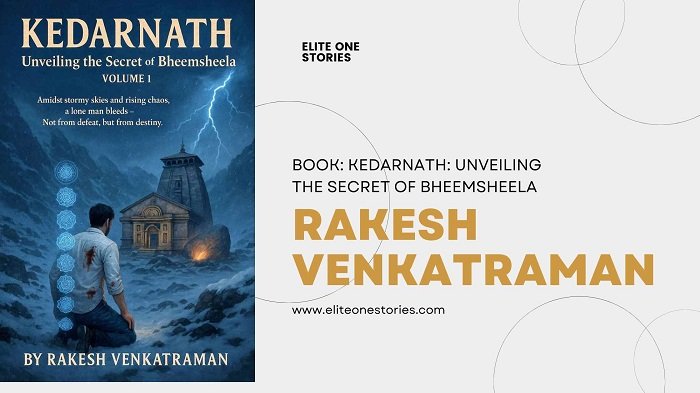Rakesh Venkatraman’s Kedarnath: Unveiling the Secret of Bheemsheela is an engrossing spiritual thriller that merges mythology, mysticism, and modern storytelling into a seamless narrative. At its heart, the book is a tale of self-discovery and destiny, following the journey of Rohan Desai, a young man from Mumbai who finds himself swept into a world far larger than the urban routines and corporate grind that once defined his existence. The novel is not just about his adventures but also about the deep cultural, spiritual, and symbolic landscape of India, particularly around the Kedarnath temple and the enigmatic Bheemsheela rock that stands as both guardian and witness to history.
The opening chapters establish Rohan as an ordinary young professional, trapped in the monotony of city life and the sterile confines of corporate drudgery. Venkatraman crafts these passages with a raw honesty that makes Rohan relatable, he is the everyman who quietly asks the questions many of us bury: Is this all there is to life? But when Rohan crosses paths with Priya, his colleague and friend, the monotony begins to shift. She becomes not only a source of warmth and light in his otherwise mechanical existence but also the catalyst who nudges him toward a deeper journey. Their friendship is delicately drawn, filled with nostalgia, shared laughter, and quiet companionship that makes their relationship believable and endearing.
The real narrative shift occurs when Rohan encounters the Aghori at Gateway of India, a mystic figure who shatters the illusion of normalcy and reveals to him a destiny that stretches back generations. Through this encounter, the story takes on its spiritual and mythological dimension, connecting Rohan’s life with the legacy of his grandfather, who was a guardian of divine knowledge and entrusted with the responsibility of protecting sacred energies hidden across the land. The revelation of the five Shiva Lingas representing the Panch Tattvas – Earth, Water, Fire, Air, and Ether, introduces the novel’s mythic framework. These Lingas are not inert symbols but living repositories of cosmic energy, their misuse threatening the balance of existence itself.
Here, Venkatraman masterfully intertwines adventure with philosophy. The Lingas are pursued not only by Rohan and his companions, Maya, a fierce warrior with a troubled past, and Arjun, a scholarly archaeologist, but also by the sinister cult Kala Surya Sangh, whose obsession with harnessing these energies threatens chaos and destruction. Each confrontation with the cult brings tension, action, and moral questioning, testing the characters’ courage and conviction. The narrative is packed with cinematic sequences, chases through Mumbai’s narrow gullies, clandestine journeys into hidden chambers beneath ancient temples, and fierce confrontations that balance mystical energy with human resilience.
What stands out in this novel is the way Venkatraman captures the spirit of place. From the bustling markets of Bhuleshwar to the silence of Babulnath Temple, from the sacred waters of Banganga to the towering presence of Kedarnath in the Himalayas, the settings are evoked with sensory precision. Readers not only visualize the landscapes but also feel their atmosphere, the fragrance of incense in temples, the dust of Mumbai’s crowded lanes, the chilling winds of the mountains, the weight of silence in underground chambers. This atmospheric detail transforms the book from a mere adventure into an immersive experience.
Rohan’s evolution as a character is another strength of the novel. He begins as a reluctant hero, uncertain of his purpose, yet as the journey unfolds, he discovers reserves of courage and clarity that surprise even him. His connection to the Lingas becomes symbolic of his own inner awakening, as he learns that true power lies not in domination but in harmony, not in control but in surrender to a higher order. His companions too add depth to the narrative, Maya, with her blend of vulnerability and ferocity, brings both emotional gravity and thrilling action, while Arjun balances the group with his scholarly wisdom and calm demeanor. Together, the trio represent a synergy of mind, body, and spirit.
Philosophically, the novel explores themes that resonate deeply with Indian spiritual traditions—the cyclical nature of life, the balance of the five elements, the thin veil between myth and reality, and the idea that destiny is not something one inherits blindly but something one chooses to embrace. The dialogues often carry this reflective tone, where action scenes are punctuated by moments of stillness and wisdom. Yet Venkatraman avoids slipping into didacticism; instead, he allows philosophy to emerge organically from the unfolding events.
The centerpiece of the story, of course, is the mysterious Bheemsheela in Kedarnath. Much like its real-life counterpart that famously shielded the temple during the 2013 floods, in the novel it becomes a powerful symbol of divine protection, resilience, and the enduring mystery of faith. The book culminates in Rohan’s confrontation not just with external enemies but also with his own doubts and fears. The revelation of Bheemsheela’s secret provides a satisfying closure that ties together the mythological threads and the protagonist’s personal journey.
Stylistically, the book reads like an audiobook brought to life, the descriptions are vivid, the dialogues natural, and the pacing fast enough to maintain suspense while giving room for reflection. The mix of English with Hindi terms, chants, and cultural references makes the narration authentic and rooted in the soil it springs from. Readers who enjoy Dan Brown–style mythological thrillers will find this book familiar in structure yet uniquely Indian in flavor and sensibility.
In conclusion, Kedarnath: Unveiling the Secret of Bheemsheela is more than just a thriller, it is a spiritual odyssey, an exploration of myth and meaning woven into a contemporary adventure. It entertains with its action, grips with its suspense, and enlightens with its philosophical undertones. Rakesh Venkatraman has successfully created a narrative that bridges the ancient and the modern, the sacred and the secular, the personal and the cosmic. For readers seeking a story that thrills the senses while also touching the spirit, this book is a compelling choice, one that lingers long after the final page, much like the eternal silence of the Himalayas themselves.



